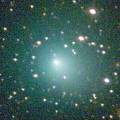
|
Now it is bright as 9.6 mag (Sept. 9, Seiichi Yoshida). It stays bright as 8-9 mag until October. It moves southwards very rapidly after this. In the Southern Hemisphere, it becomes observable in excellent condition after this. In the Northern Hemisphere, it will be getting lower after this, and it will be unobservable in November.
Date(TT) R.A. (2000) Decl. Delta r Elong. m1 Best Time(A, h)
Sept.14 1 50.53 45 43.9 0.659 1.459 121 9.1 2:24 (180, 9)
Sept.21 0 50.01 32 47.1 0.537 1.471 143 8.7 0:57 (180, 21)
|

|
Now it is 11.6 mag (Sept. 11, Maik Meyer). It stays bright as 11 mag until winter. It stays observable in good condition for a long time in the Northern Hemisphere. In the Southern Hemisphere, it will be getting lower gradually, and it will be unobservable in early December.
Date(TT) R.A. (2000) Decl. Delta r Elong. m1 Best Time(A, h)
Sept.14 2 20.86 27 18.7 2.460 3.175 127 11.5 2:52 (180, 28)
Sept.21 2 11.09 29 22.3 2.375 3.164 134 11.4 2:15 (180, 26)
|
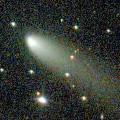
|
Now it is 11.6 mag (Sept. 9, Seiichi Yoshida). It stays 12 mag until November. It is observable in excellent condition in the Northern Hemisphere. It will be extremely low after October in the Southern Hemisphere.
Date(TT) R.A. (2000) Decl. Delta r Elong. m1 Best Time(A, h)
Sept.14 2 36.66 29 14.2 0.586 1.417 123 11.7 3:07 (180, 26)
Sept.21 2 43.91 33 28.4 0.572 1.422 126 11.6 2:47 (180, 22)
|

|
It has not been observed yet in this apparition. Now it is fainter than 21.5 mag (Aug. 4, Erwin Schwab). It was expected to brighten up to 12 mag from August to September. But actually, it must be much fainter than expected. It is observable in good condition in the Northern Hemisphere. In the Southern Hemisphere, it will be unobservable soon.
Date(TT) R.A. (2000) Decl. Delta r Elong. m1 Best Time(A, h)
Sept.14 5 35.27 43 19.3 1.101 1.435 85 12.0 4:38 (196, 9)
Sept.21 5 56.91 45 40.6 1.094 1.462 88 12.2 4:27 (196, 7)
|
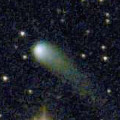
|
Now it is 12.2 mag (Sept. 11, Maik Meyer). It is expected to brighten up to 8 mag in 2020. It stays observable in good condition for a long time in the Northern Hemisphere. In the Southern Hemisphere, it will be getting lower gradually, and it will be unobservable in early December.
Date(TT) R.A. (2000) Decl. Delta r Elong. m1 Best Time(A, h)
Sept.14 5 28.54 24 33.5 3.198 3.316 87 12.5 4:38 (201, 27)
Sept.21 5 32.49 25 41.5 3.026 3.249 93 12.3 4:27 (197, 27)
|

|
It brightened rapidly. Now it is very bright as 11.5 mag (Sept. 3, Chris Wyatt). It may fade out rapidly after this. In the Southern Hemisphere, it stays observable in the low sky until it becomes fainter than 18 mag in winter. It is not observable at all in the Northern Hemisphere.
Date(TT) R.A. (2000) Decl. Delta r Elong. m1 Best Time(A, h)
Sept.14 10 3.67 -48 12.1 1.933 1.586 54 13.0 4:38 (312, 26)
Sept.21 10 39.69 -52 41.3 1.968 1.630 55 13.4 4:27 (318, 25)
|

|
Now it is 14.7 mag (Sept. 5, Chris Wyatt).
Date(TT) R.A. (2000) Decl. Delta r Elong. m1 Best Time(A, h)
Sept.14 0 52.32 16 12.2 4.875 5.774 150 13.2 1:23 (180, 39)
Sept.21 0 49.43 16 3.1 4.833 5.774 157 13.1 0:53 (180, 39)
|
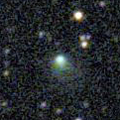
|
Now it is 13.3 mag (Aug. 28, Chris Wyatt). It is observable at 13.5 mag in good condition in autumn.
Date(TT) R.A. (2000) Decl. Delta r Elong. m1 Best Time(A, h)
Sept.14 17 50.70 -11 44.2 1.475 1.883 96 13.8 19:13 (149, 64)
Sept.21 18 2.23 -12 40.8 1.516 1.862 93 13.8 19:19 (138, 62)
|

|
Now it is 15.7 mag (Sept. 3, Steffen Fritsche). It is observable at 14 mag in good condition in autumn.
Date(TT) R.A. (2000) Decl. Delta r Elong. m1 Best Time(A, h)
Sept.14 8 13.04 14 55.7 2.941 2.399 48 13.9 4:38 (241, 13)
Sept.21 8 24.44 14 6.4 2.903 2.428 52 14.0 4:27 (240, 15)
|

|
Now it is 13.9 mag (Sept. 5, Chris Wyatt). It stays 13-14 mag for a long time in 2019. In the Southern Hemisphere, it is observable in good condition. In the Northern Hemisphere, it is not observasble until summer in 2020.
Date(TT) R.A. (2000) Decl. Delta r Elong. m1 Best Time(A, h)
Sept.14 9 27.27 -72 44.9 3.101 3.067 78 14.0 4:38 (339, 36)
Sept.21 9 45.54 -75 34.1 3.114 3.079 78 14.0 4:27 (342, 36)
|

|
It brightened up to 7.7 mag in June in 2018 (June 19, Juan Jose Gonzalez). Now it is fading. It has already faded down to 14.3 mag (Aug. 24, Thomas Lehmann). In the Southern Hemisphere, it stays observable for a long time until the comet will fade out. In the Northern Hemisphere, it will appear in the morning sky in late September. But it stays low for a while after that.
Date(TT) R.A. (2000) Decl. Delta r Elong. m1 Best Time(A, h)
Sept.14 7 2.88 -30 17.3 4.970 4.742 71 14.4 4:38 (275, 53)
Sept.21 7 4.07 -30 46.9 4.963 4.800 74 14.5 4:27 (274, 57)
|

|
Now it is 14.0 mag (Sept. 5, Chris Wyatt). In the Southern Hemisphere, it is observable for a long time. It stays low in the Northern Hemisphere.
Date(TT) R.A. (2000) Decl. Delta r Elong. m1 Best Time(A, h)
Sept.14 23 32.29 -44 46.0 3.559 4.368 138 14.9 0:04 ( 0, 80)
Sept.21 23 24.35 -44 1.3 3.611 4.395 136 14.9 23:24 ( 0, 81)
|

|
Now it is 14.8 mag (Aug. 28, Chris Wyatt). It will be fading slowly after this. In the Southern Hemisphere, it stays observable in good condition for a long time, although it becomes low from October to November. It will never be observable after this in the Northern Hemisphere.
Date(TT) R.A. (2000) Decl. Delta r Elong. m1 Best Time(A, h)
Sept.14 13 39.11 -44 19.2 4.413 3.948 56 15.2 19:13 ( 55, 33)
Sept.21 13 41.87 -44 56.1 4.521 3.985 52 15.3 19:19 ( 53, 28)
|
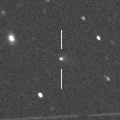
|
Now it is 15.5-16.0 mag (Sept. 8, Koremasa Hirofumi). It stays 15.5 mag until December, and it is observable in good condition.
Date(TT) R.A. (2000) Decl. Delta r Elong. m1 Best Time(A, h)
Sept.14 0 0.18 -7 40.4 1.564 2.562 170 15.9 0:32 (180, 63)
Sept.21 23 56.67 -8 16.3 1.540 2.539 172 15.8 0:01 (180, 63)
|

|
Now it is 16.7 mag (Sept. 1, Toshihiko Ikemura, Hirohisa Sato). It is observable at 16 mag in good condition from summer to autumn. It locates somewhat low in the Southern Hemisphere.
Date(TT) R.A. (2000) Decl. Delta r Elong. m1 Best Time(A, h)
Sept.14 3 40.37 27 59.6 1.545 2.125 111 15.9 4:11 (180, 27)
Sept.21 3 44.71 28 29.1 1.494 2.143 116 15.9 3:48 (180, 26)
|
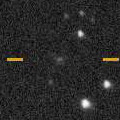
|
Now it is 15.0 mag (July 21, Taras Prystavski). It stays 16 mag for a long time from 2019 to 2020. It stays observable for a long time in the Southern Hemisphere. It is hardly observable in the Northern Hemisphere.
Date(TT) R.A. (2000) Decl. Delta r Elong. m1 Best Time(A, h)
Sept.14 11 29.76 -58 44.9 3.871 3.521 62 15.9 19:13 ( 31, 21)
Sept.21 11 36.70 -60 9.0 3.879 3.508 61 15.9 4:27 (329, 22)
|
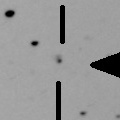
|
It looks cometary on the LCO (CTIO) image on Aug. 21. Now it is 15.7 mag (Aug. 28, Taras Prystavski). It is observable in excellent condition in the Southern Hemisphere. In the Northern Hemisphere, it locates extremely low for a while.
Date(TT) R.A. (2000) Decl. Delta r Elong. m1 Best Time(A, h)
Sept.14 20 15.63 -42 12.9 5.815 6.417 122 16.0 20:43 ( 0, 83)
Sept.21 20 8.77 -41 45.0 5.917 6.418 115 16.1 20:09 ( 0, 83)
|
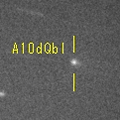
|
Now it is 15.8 mag (Aug. 26, Toshihiko Ikemura, Hirohisa Sato). It stays observable in good condition while the comet will be fading slowly after this.
Date(TT) R.A. (2000) Decl. Delta r Elong. m1 Best Time(A, h)
Sept.14 3 27.44 7 3.2 1.600 2.262 118 16.1 3:58 (180, 48)
Sept.21 3 31.20 6 0.4 1.576 2.299 124 16.1 3:34 (180, 49)
|

|
Now it is 16.0 mag (Sept. 5, Katsumi Yoshimoto). It looks cometary. It is observable at 15.5 mag in good condition from October to November.
Date(TT) R.A. (2000) Decl. Delta r Elong. m1 Best Time(A, h)
Sept.14 6 0.22 21 31.8 2.374 2.423 80 16.2 4:38 (210, 27)
Sept.21 5 51.04 20 27.9 2.223 2.432 89 16.1 4:27 (204, 31)
|

|
Now it is 16.5 mag (July 27, Kevin Hills). It will brighten up to 14 mag in winter. It stays observable for a long time in the Southern Hemisphere, although it becomes low in November. In the Northern Hemisphere, it is not observable for a long time until August in 2020.
Date(TT) R.A. (2000) Decl. Delta r Elong. m1 Best Time(A, h)
Sept.14 14 53.76 -40 32.5 2.962 2.693 64 16.2 19:13 ( 65, 45)
Sept.21 14 55.77 -41 35.4 3.003 2.642 59 16.1 19:19 ( 62, 39)
|

|
Now it is 16.0 mag (Sept. 1, Toshihiko Ikemura, Hirohisa Sato). It stays 15-16 mag for a long time until 2021.
Date(TT) R.A. (2000) Decl. Delta r Elong. m1 Best Time(A, h)
Sept.14 20 27.33 -31 25.6 4.296 5.000 129 16.2 20:55 (180, 86)
Sept.21 20 20.67 -30 33.8 4.368 4.976 122 16.2 20:21 (180, 85)
|
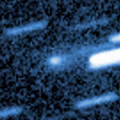
|
First return of a new periodic comet which brightened up to 16.5 mag in 2009. Now it is 16.2 mag (Sept. 3, G. Borisov). It stays 16.5 mag until October. It is observable in good condition in the Northern Hemisphere. It locates low in the Southern Hemisphere.
Date(TT) R.A. (2000) Decl. Delta r Elong. m1 Best Time(A, h)
Sept.14 7 35.63 22 59.8 1.459 1.272 58 16.4 4:38 (228, 14)
Sept.21 8 0.74 21 4.6 1.457 1.283 59 16.4 4:27 (231, 14)
|

|
Now it is 16.3 mag (Sept. 1, Toshihiko Ikemura, Hirohisa Sato). It is expected to be observable at 5-6 mag for a long time from 2022 to 2023. In the Northern Hemisphere, it is not observable at the highlight from 2022 summer to 2023 summer. In the Southern Hemisphere, it stays unobservable for a while. But it will be observable in good condition at the highlight.
Date(TT) R.A. (2000) Decl. Delta r Elong. m1 Best Time(A, h)
Sept.14 17 6.95 52 30.4 10.921 10.866 84 16.6 19:13 (165, 0)
Sept.21 17 7.43 51 47.5 10.903 10.819 82 16.5 19:19 (160, -1)
|
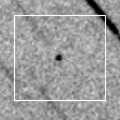
|
It passed the perihelion on July 2. Then it must have brightened up to 13 mag, but it was not observable around that time. In the Northern Hemisphere, it stays observable in excellent condition until December when it becomes fainter than 18 mag. In the Southern Hemisphere, it stays locating low.
Date(TT) R.A. (2000) Decl. Delta r Elong. m1 Best Time(A, h)
Sept.14 4 17.84 52 22.4 0.959 1.475 97 16.7 4:38 (182, 3)
Sept.21 3 54.29 53 33.4 0.940 1.553 105 16.7 3:59 (180, 1)
|

|
Fading now. Now it is 15.8 mag (Aug. 24, Thomas Lehmann). In the Southern Hemisphere, it stays observable for a long time until it fades out. In the Northern Hemisphere, it will not be observable after this.
Date(TT) R.A. (2000) Decl. Delta r Elong. m1 Best Time(A, h)
Sept.14 6 45.73 -37 34.0 5.060 4.925 76 16.7 4:38 (286, 58)
Sept.21 6 45.65 -39 19.6 5.051 4.977 80 16.8 4:27 (289, 62)
|

|
Now it is 18.4 mag (Aug. 1, iTelescope Observatory, Siding Spring). It will brighten up to 16 mag in autumn. It is observable in good condition in the Southern Hemisphere. It locates somewhat low in the Northern Hemisphere.
Date(TT) R.A. (2000) Decl. Delta r Elong. m1 Best Time(A, h)
Sept.14 18 40.15 -32 36.3 1.371 1.931 107 16.8 19:13 (160, 87)
Sept.21 18 48.55 -31 1.5 1.414 1.908 102 16.7 19:19 (122, 83)
|

|
It approached to Earth down to 0.3 a.u. in mid February, and brightened up to 5.5 mag (Feb. 13, Juan Jose Gonzalez). Now it is fading. It has already faded down to 16.9 mag (Aug. 23, Thomas Lehmann).
Date(TT) R.A. (2000) Decl. Delta r Elong. m1 Best Time(A, h)
Sept.14 3 57.72 43 3.5 2.803 3.187 103 16.8 4:29 (180, 12)
Sept.21 3 43.43 43 22.3 2.751 3.260 111 16.9 3:47 (180, 12)
|
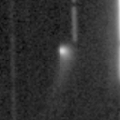
|
Now it is 16.8 mag (Aug. 2, Charles Morris). It will be fading after this. In the Northern Hemisphere, it stays observable in good condition for a long time. In the Southern Hemisphere, it stays extremely low for a long time.
Date(TT) R.A. (2000) Decl. Delta r Elong. m1 Best Time(A, h)
Sept.14 3 46.29 49 59.6 3.642 3.986 102 16.8 4:18 (180, 5)
Sept.21 3 34.55 49 50.7 3.562 4.022 110 16.8 3:38 (180, 5)
|

|
Fading. It stays 17 mag from autumn to winter. It is observable in good condition in the Northern Hemisphere. It locates low in the Southern Hemisphere.
Date(TT) R.A. (2000) Decl. Delta r Elong. m1 Best Time(A, h)
Sept.14 9 16.80 25 38.4 6.861 6.099 37 16.8 4:38 (242, -5)
Sept.21 9 18.32 25 16.8 6.824 6.142 44 16.8 4:27 (240, -2)
|

|
Now it is 16.6 mag (Sept. 2, Toshihiko Ikemura, Hirohisa Sato). It is observable at 17 mag in good condition from August to September. It will be fainter than 18 mag in November.
Date(TT) R.A. (2000) Decl. Delta r Elong. m1 Best Time(A, h)
Sept.14 0 18.93 11 54.8 1.510 2.478 159 16.8 0:51 (180, 43)
Sept.21 0 4.07 6 17.3 1.512 2.511 171 16.9 0:08 (180, 48)
|

|
Now it is 18.3 mag (Aug. 23, A. Diepvens). It will brighten very rapidly, and it will brighten up to 14 mag in winter. It is observable in excellent condition in the Northern Hemisphere. It locates low in the Southern Hemisphere.
Date(TT) R.A. (2000) Decl. Delta r Elong. m1 Best Time(A, h)
Sept.14 2 14.67 42 47.0 1.277 1.981 119 17.5 2:45 (180, 12)
Sept.21 2 19.22 44 7.6 1.194 1.943 124 17.2 2:23 (180, 11)
|
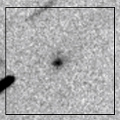
|
Now it is 17.1 mag (Sept. 10, D. T. Durig). The orbit is extremely hyperbolic with e=3.2. It seems to be a first interstellar comet in history. It brightens up to 15 mag in December. In the Northern Hemisphere, it stays observable in good condition until early December. Then it will be getting lower, and it will be unobservable in mid January. In the Southern Hemisphere, it is not observable for a while. But it will appear in the morning sky in late October, then it will be observable in excellent condition.
Date(TT) R.A. (2000) Decl. Delta r Elong. m1 Best Time(A, h)
Sept.14 8 54.68 29 17.8 3.357 2.723 43 17.5 4:38 (236, -3)
Sept.21 9 7.77 26 56.1 3.204 2.622 46 17.2 4:27 (237, -1)
|

|
Now it is 19.4 mag (Aug. 14, Slooh.com Canary Islands Observatory). It is predicted to brighten up to 16.5 mag in winter, and it will be observable in good condition. But it is fainter than this ephemeris recently. It locates somewhat low in the Southern Hemisphere.
Date(TT) R.A. (2000) Decl. Delta r Elong. m1 Best Time(A, h)
Sept.14 4 28.33 24 37.8 2.983 3.330 101 17.4 4:38 (186, 30)
Sept.21 4 31.90 24 48.4 2.879 3.321 107 17.3 4:27 (182, 30)
|
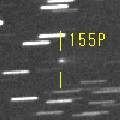
|
Now it is 17.4 mag (Sept. 9, Toshihiko Ikemura, Hirohisa Sato). It brightens rapidly, and it will be observable at 15 mag in good condition in winter. It locates somewhat low in the Southern Hemisphere.
Date(TT) R.A. (2000) Decl. Delta r Elong. m1 Best Time(A, h)
Sept.14 7 16.35 20 35.2 2.163 1.924 62 17.6 4:38 (226, 19)
Sept.21 7 34.72 20 14.6 2.084 1.899 65 17.3 4:27 (227, 19)
|
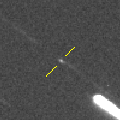
|
First return of a new periodic comet which brightened up to 18 mag in 2014. Now it is 17.7 mag (Sept. 6, Toshihiko Ikemura, Hirohisa Sato). It stays 17 mag until November. It is observable in good condition in the Northern Hemisphere. It locates extremely low in the Southern Hemisphere.
Date(TT) R.A. (2000) Decl. Delta r Elong. m1 Best Time(A, h)
Sept.14 3 20.09 23 15.6 0.295 1.169 116 17.6 3:50 (180, 32)
Sept.21 4 0.84 29 4.3 0.284 1.146 113 17.3 4:03 (180, 26)
|

|
Now it is 19.2 mag (Sept. 9, Toshihiko Ikemura, Hirohisa Sato). It brightens up to 16.5 mag from October to December. It is observable in good condition in the Northern Hemisphere. It locates low in the Southern Hemisphere.
Date(TT) R.A. (2000) Decl. Delta r Elong. m1 Best Time(A, h)
Sept.14 6 34.34 10 54.4 1.656 1.658 72 17.6 4:38 (224, 32)
Sept.21 6 51.58 12 8.3 1.587 1.642 74 17.4 4:27 (223, 31)
|

|
It brightened up to 13.0 mag in May (May 15, Thomas Lehmann). Now it is fading. It has already faded down to 17.6 mag (Sept. 1, Toshihiko Ikemura, Hirohisa Sato). It is observable in excellent condition in the Northern Hemisphere. It locates extremely low in the Southern Hemisphere.
Date(TT) R.A. (2000) Decl. Delta r Elong. m1 Best Time(A, h)
Sept.14 1 6.24 44 20.8 1.525 2.276 126 17.6 1:38 (180, 10)
Sept.21 1 1.78 42 52.9 1.533 2.338 133 17.8 1:06 (180, 12)
|

|
Now it is fading. In 2019, it is observable at 17.5 mag in good condition in autumn.
Date(TT) R.A. (2000) Decl. Delta r Elong. m1 Best Time(A, h)
Sept.14 2 55.83 11 13.1 3.443 4.112 125 17.7 3:27 (180, 44)
Sept.21 2 54.11 11 6.1 3.376 4.125 132 17.7 2:57 (180, 44)
|

|
Now it is 17.5 mag (Sept. 1, Toshihiko Ikemura, Hirohisa Sato). It will brighten up to 12 mag in winter in 2022.
Date(TT) R.A. (2000) Decl. Delta r Elong. m1 Best Time(A, h)
Sept.14 22 19.47 47 32.0 7.204 7.847 126 17.7 22:46 (180, 7)
Sept.21 22 15.76 47 20.2 7.151 7.802 127 17.7 22:15 (180, 8)
|

|
It was observed in the SOHO spacecraft images in 2008 and 2014. It will approach to Sun down to 0.067 a.u. on Oct. 9. It is observable in the evening low sky until late September. But it must be extremely faint.
Date(TT) R.A. (2000) Decl. Delta r Elong. m1 Best Time(A, h)
Sept.14 14 57.62 -19 31.5 0.742 0.866 57 18.7 19:13 ( 92, 37)
Sept.21 14 34.45 -15 37.5 0.757 0.695 43 17.8 19:19 ( 87, 24)
|

|
First return of a new periodic comet which brightened up to 17 mag in 2006. It has not been recovered yet in this apparition. It will brighten up to 18 mag in autumn. It is observable in good condition in the Southern Hemisphere. It locates extremely low in the Northern Hemisphere.
Date(TT) R.A. (2000) Decl. Delta r Elong. m1 Best Time(A, h)
Sept.14 17 3.65 -36 18.6 2.353 2.523 87 17.9 19:13 ( 79, 70)
Sept.21 17 14.68 -35 56.8 2.417 2.507 83 17.9 19:19 ( 79, 65)
|
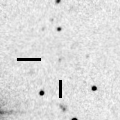
|
It is observable at 17-18 mag for a long time from late 2019 to early 2021.
Date(TT) R.A. (2000) Decl. Delta r Elong. m1 Best Time(A, h)
Sept.14 3 32.34 2 43.6 4.748 5.296 118 18.0 4:03 (180, 52)
Sept.21 3 31.93 2 28.6 4.647 5.282 124 17.9 3:35 (180, 52)
|

|
First return of a new periodic comet discovered in 2006. It has not been recovered yet in this apparition. It will brighten up to 16.5 mag in 2020 spring. But it is not observable at that time. It will be observable at 18 mag in 2019 autumn and 2020 autumn.
Date(TT) R.A. (2000) Decl. Delta r Elong. m1 Best Time(A, h)
Sept.14 18 45.94 -11 7.1 2.173 2.694 110 18.0 19:14 (180, 66)
Sept.21 18 48.16 -12 3.3 2.212 2.645 104 17.9 19:19 (162, 66)
|

|
Now it is bright as 17 mag (Aug. 23, Hidetaka Sato). Hidetaka Sato reported it looks cometary with coma. It will be getting lower gradually after this.
Date(TT) R.A. (2000) Decl. Delta r Elong. m1 Best Time(A, h)
Sept.14 17 53.50 -11 28.3 4.374 4.615 97 19.7 19:13 (150, 64)
Sept.21 17 56.12 -11 47.4 4.475 4.612 91 19.7 19:19 (136, 60)
|
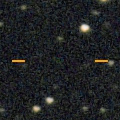
|
Now it is very faint as 20.5 mag (Sept. 12, Francois Kugel). It brightened up to 15.5 mag in 1997, and 17 mag in 2008, however, it is much fainter in this apparition.
Date(TT) R.A. (2000) Decl. Delta r Elong. m1 Best Time(A, h)
Sept.14 1 35.11 20 22.0 2.472 3.307 140 20.2 2:06 (180, 35)
Sept.21 1 32.86 20 3.4 2.421 3.311 147 20.1 1:36 (180, 35)
|

|
Now it is 20.15 mag (Aug. 31, Fornari-Ferrin). It will approaches to Earth down to 0.09 a.u. in early January. It will be obesrvable in excellent condition in the Northern Hemisphere. But it will be 17.5 mag at best. In the Southern Hemisphere, it will not be observable at the high light.
Date(TT) R.A. (2000) Decl. Delta r Elong. m1 Best Time(A, h)
Sept.14 23 32.15 -19 33.7 0.625 1.616 164 21.2 0:04 (180, 74)
Sept.21 23 22.46 -21 10.7 0.573 1.552 158 21.0 23:21 (180, 76)
|
|
![]()
 C/2017 T2 ( PanSTARRS )
C/2017 T2 ( PanSTARRS ) C/2019 A9 ( PanSTARRS )
C/2019 A9 ( PanSTARRS ) 29P/Schwassmann-Wachmann 1
29P/Schwassmann-Wachmann 1 68P/Klemola
68P/Klemola 78P/Gehrels 2
78P/Gehrels 2 C/2018 A6 ( Gibbs )
C/2018 A6 ( Gibbs ) C/2016 M1 ( PanSTARRS )
C/2016 M1 ( PanSTARRS ) C/2017 B3 ( LINEAR )
C/2017 B3 ( LINEAR ) C/2017 M4 ( ATLAS )
C/2017 M4 ( ATLAS ) 101P/Chernykh
101P/Chernykh 261P/Larson
261P/Larson C/2018 F4 ( PanSTARRS )
C/2018 F4 ( PanSTARRS ) A/2017 U7
A/2017 U7 C/2019 K5 ( Young )
C/2019 K5 ( Young ) 2018 DO4
2018 DO4 C/2019 K1 ( ATLAS )
C/2019 K1 ( ATLAS ) C/2019 K7 ( Smith )
C/2019 K7 ( Smith ) P/2019 R1 ( Boattini )
P/2019 R1 ( Boattini ) C/2017 K2 ( PanSTARRS )
C/2017 K2 ( PanSTARRS ) (3200) Phaethon
(3200) Phaethon C/2016 N6 ( PanSTARRS )
C/2016 N6 ( PanSTARRS ) 160P/LINEAR
160P/LINEAR C/2018 Y1 ( Iwamoto )
C/2018 Y1 ( Iwamoto ) C/2018 A3 ( ATLAS )
C/2018 A3 ( ATLAS ) C/2015 O1 ( PanSTARRS )
C/2015 O1 ( PanSTARRS ) C/2019 K4 ( Ye )
C/2019 K4 ( Ye ) 114P/Wiseman-Skiff
114P/Wiseman-Skiff C/2019 Q4 ( Borisov )
C/2019 Q4 ( Borisov ) 203P/Korlevic
203P/Korlevic 155P/Shoemaker 3
155P/Shoemaker 3 P/2019 O1 ( Kowalski )
P/2019 O1 ( Kowalski ) 76P/West-Kohoutek-Ikemura
76P/West-Kohoutek-Ikemura C/2019 D1 ( Flewelling )
C/2019 D1 ( Flewelling ) 65P/Gunn
65P/Gunn C/2019 L3 ( ATLAS )
C/2019 L3 ( ATLAS ) P/2008 Y12 = P/2014 K3 ( SOHO )
P/2008 Y12 = P/2014 K3 ( SOHO ) P/2006 H1 ( McNaught )
P/2006 H1 ( McNaught ) 173P/Mueller 5
173P/Mueller 5 P/2006 W1 ( Gibbs )
P/2006 W1 ( Gibbs ) 2019 LD2
2019 LD2 200P/Larsen
200P/Larsen 289P/Blanpain
289P/Blanpain![]()



































